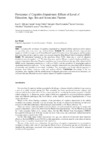Prevalence of cognitive impariment: effects of level of education, age, sex, and associated factors

Use este enlace para citar
http://hdl.handle.net/2183/14352Coleccións
- GI-GIGG - Artigos [115]
Metadatos
Mostrar o rexistro completo do ítemTítulo
Prevalence of cognitive impariment: effects of level of education, age, sex, and associated factorsAutor(es)
Data
2009-11-10Cita bibliográfica
Millán-Calenti JC, Tubío J, Pita-Fernández S, González-Abraldes I, Lorenzo T, Maseda A. Prevalence of cognitive impariment: effects of level of education, age, sex, and associated factors. Dement Geriatr Cogn Disord. 2009;28:455-460.
Resumo
[Abstract] Aims: To examine the prevalence of cognitive impairment in a Spanish elderly population and to analyse its association with some social and medical factors. Methods: We randomly selected a representative sample (n = 600) of people over 65 from Narón Council (A Coruña). Socio-demographic and biomedical data were collected and cognitive status was assessed using the Mini-Mental State Examination (MMSE). Results: We determined variations in the prevalence from 35.2%, when age or level of education distribution was not applied, to 22.2% when they were applied. Women showed a higher probability of cognitive impairment than men. Negative correlation was observed between the age of the subject and the MMSE secore (Spearman correlation p = -0.45, p < 0.001), with the possibility of developing cognitive impairment increasing each year. For our sample, cognitive impairment was associated with an increase of morbidity and mortality in the elderly population. This association was found with the presence of dementia. heart failure. anaemia, stroke and auditory deficits. Conclusions: Knowledge of the real prevalence rates, together with the establishment of adequate preventive and intervention measures, can be factors that may diminish the socio-sanitary impact of cognitive impairment.
Palabras chave
Level of education
Cognitive impairment
Elderly
Associated factors
Cognitive impairment
Elderly
Associated factors





